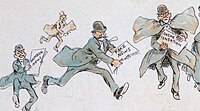
Photo from wikipedia
ABSTRACT Solidarity among society is considered crucial to tackle the corona pandemic. With the crisis evoking a high need for orientation, the information people obtain from different sources may shape… Click to show full abstract
ABSTRACT Solidarity among society is considered crucial to tackle the corona pandemic. With the crisis evoking a high need for orientation, the information people obtain from different sources may shape whether they feel a strong sense of cohesion in the pandemic. To test this assumption, an online two-wave panel survey among a quota sample representing the German population aged 18+ was conducted in March and April 2020. Applying a path model, we show that using high-quality news media for information on the corona crisis (e.g., public broadcasting services) nourished people’s sense of cohesion, while using alternative and hyperpartisan news sites had a detrimental effect. Relying on information from low-quality news media (e.g., tabloids) did not affect people’s sense of cohesion, while talking to private contacts had a limited positive effect. Perceiving the public discourse as constructive vs. dramatized mediated the effects. These insights illustrate how the news media and other information sources in high-choice media environments contribute to a solid vs. polarized community in disruptive times of a crisis.
Journal Title: Journalism Studies
Year Published: 2021
Link to full text (if available)
Share on Social Media: Sign Up to like & get
recommendations!